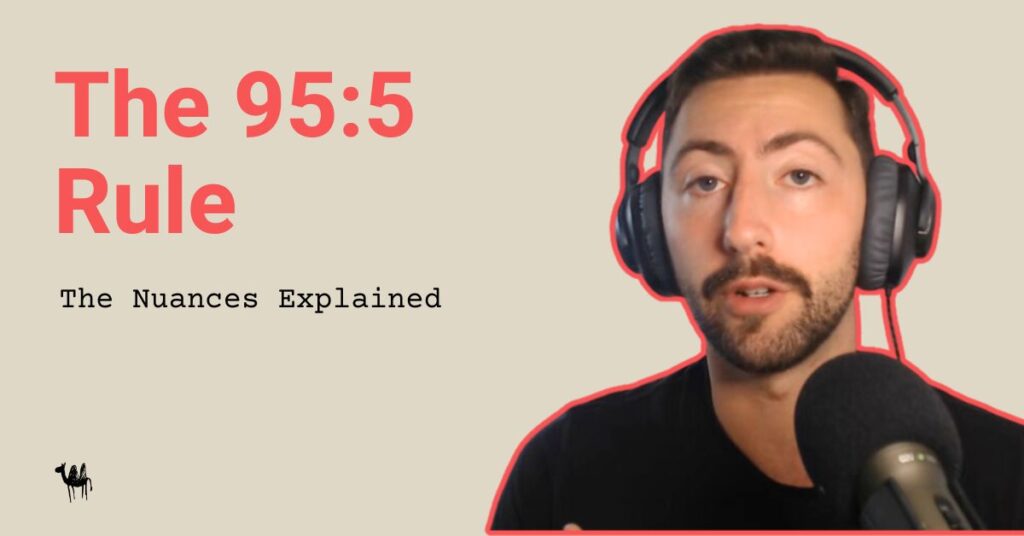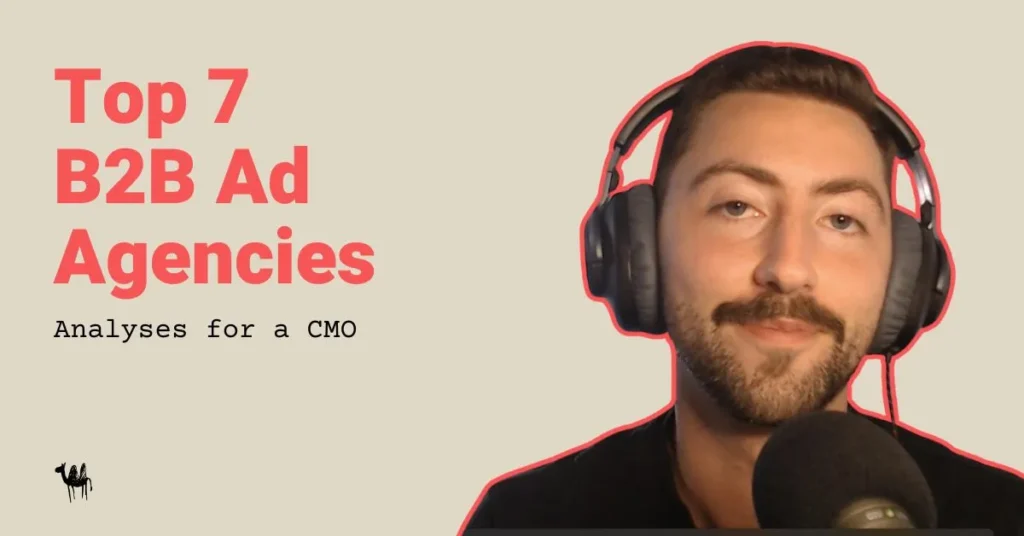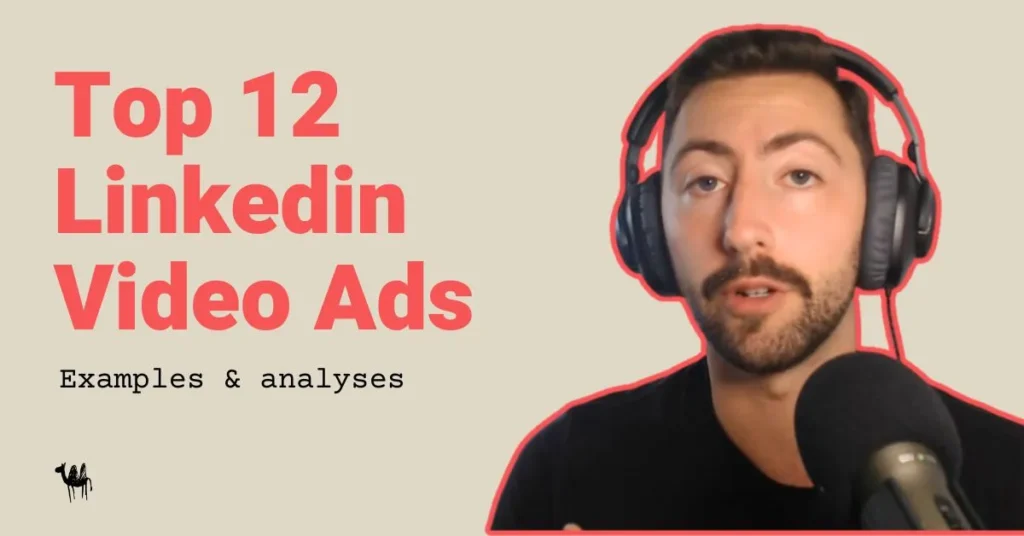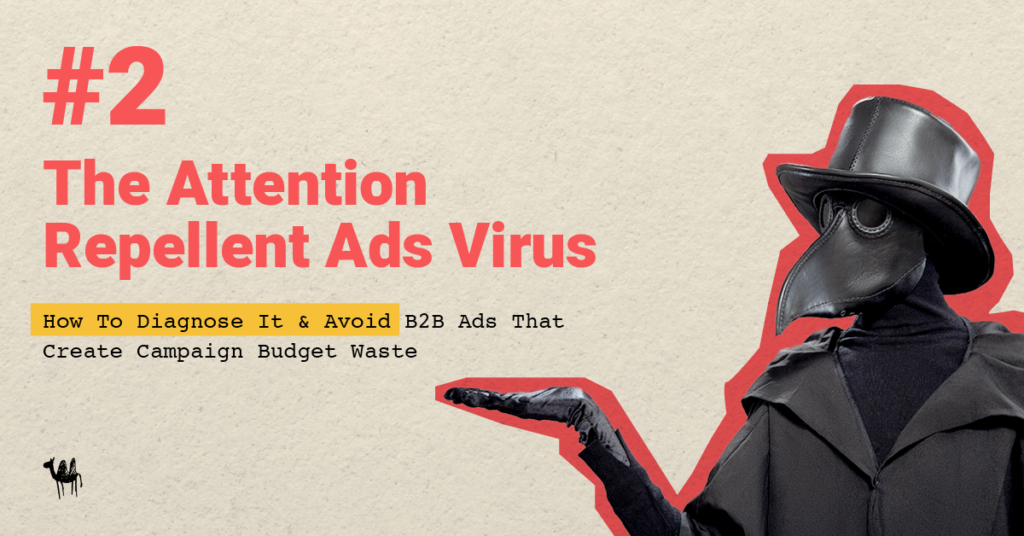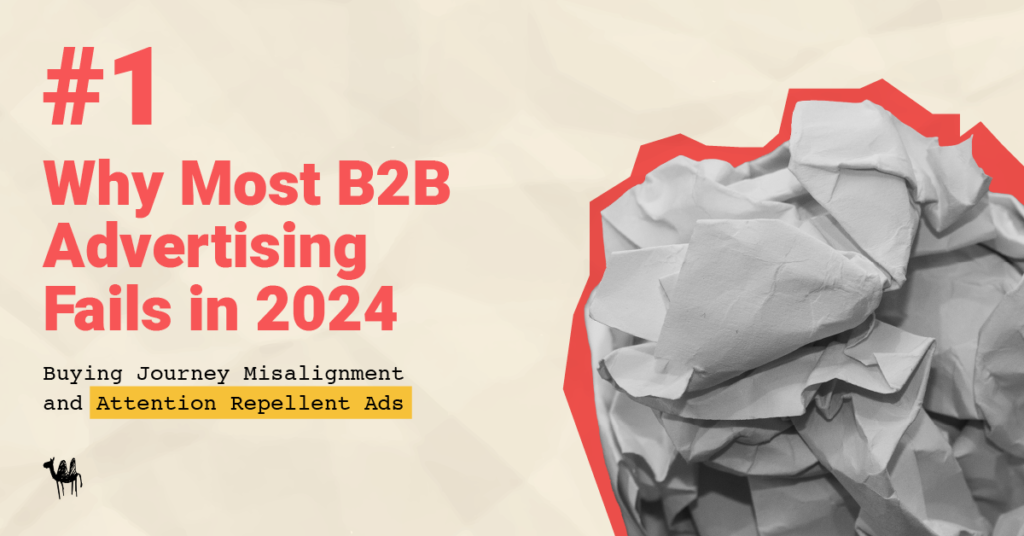Written by Dylan Ciaccio and Regan George
B2B Messaging Affects Your Entire B2B Company’s Success
The year is 2024.
And most of B2B struggles with 3 key parts of a sustainable business:
Growth:
They struggle to attract qualified sales calls/demos with the intention of buying.
Profitability:
To get ‘leads’ that actually end up buying, the marketing costs are too high.
Scalability:
The sales cycles are extremely long and the LTV is too low.
Is it a marketing problem? Is it a sales problem? A product problem? A customer success problem?
Surely, if the pains are experienced in the entire business, it must be a variety of problems in each department. Right?
Perhaps that plays a part in it. But we’ve actually found that there’s one underlying factor that affects the entire business’ success:
Perception.
And perception is created from the very first advertisement buyers see from you.
The problem is that most B2B companies do advertising that makes buyers perceive them as an Interchangeable & Nice-To-Have service.
1) Buyers perceive you as a Nice-To-Have, not a Need-To-Have.
When they don’t NEED your product/service:
👉 There’s no urgency to book a call with you.
👉 There’s no urgency to buy.
👉 There’s no urgency to get started after buying.
They might see it as somewhat important, but not urgent.
And when there’s no urgency, Need-To-Haves are always prioritized.
When it’s perceived as Nice-To-Have, people ask, ‘How much does it cost?’
When it’s perceived as Need-To-Have, people say, ‘Name your price.’
When it’s perceived as Nice-To-Have, people say, ‘Let me think about it and get back to you.’
When it’s perceived as Need-To-Have, people say, ‘Tell me what you need so we can start today.’
2) Buyers perceive you as Interchangeable, not Irreplaceable.
You might see your service as unique and amazing and think that it can’t be found anywhere else. But if buyers see it as a commodity that performs the same function as other services. . .
👉 Why would they book calls with you, not the 20 other options?
👉 Why would they buy from you, not the 20 other options?
👉 Why would they pay such a high price to you, not the 20 other options?
The reality could be that your service may actually be better than the rest and completely different to other offerings. But what matters is the perceived reality of the buyer.
No amount of telling buyers that you’re amazing and better will change that.
B2B Marketers say:
- “People buy from people they trust”
- “You need to show the benefits, not the features”
- “You need to reduce the perceived risk of buying”
- “You need to give value”
- “You need to show how you help”
- “Your brand colors need to create a brand identity”
- “You need to show you’re an expert in the industry”
But here’s the thing…
You can have all of the above and still be perceived as an Interchangeable Nice-To-Have. How come?
Perception Depends On Your B2B Messaging
How you’re perceived by buyers depends on the focus of your message (problem-focused vs solution-focused) and at what point of the buying journey they receive that message.
Why?
- Perception starts from the first moment buyers are introduced to your brand.
- Your solution is not perceived as a solution without the perception of a problem.
Remember: The decision process that initiates the buying journey starts with the problem. And 95% of your Target Addressable Market is ‘out-of-market’ (B2B Institute). That’s because they aren’t aware of the problem or of how the problem is causing them their current pains.

When you make your solution the focus of your Top of Funnel ad messages, buyers perceive you as an Interchangeable Nice-To-Have service.
When you make the problem the focus of your Top of Funnel ad messages, buyers perceive you as the Irreplaceable Need-To-Have solution.
Sidenote: We’re not advocating for never talking about the solution. The farther the buyers go into their buying journey, naturally the more they will need to understand the solution to the problem. But in the beginning of the journey (your ToFu ads) need to be focused on the problem. We call this Buying Journey Alignment.
How Your Messaging Shows Up In The Results
The difference between messaging is the difference between Ad Campaign Budget Waste and Ad Campaign Success.
Advertising the solution in the Top of Funnel results in being perceived as an Interchangeable Nice-To-Have which results in being deprioritized and ignored.
→ few high intent inbound calls (no one needs something that doesn’t solve a problem)
→ lower win rate (prospects see you as one of many possible solutions)
→ longer sales cycles (without pain, there’s no urgency nor prioritization)
All of which leads to Ad Budget Waste – you’re spending much more on ads than needed to drive the same amount of revenue.
Marketing the problem in the Top of Funnel results in being perceived as an Irreplaceable Need-To-Have which results in buyers demanding the solution from you without considering anyone else.
→ more high intent inbound calls (painful problems need solutions)
→ higher win rate (prospects see you as the only obvious solution)
→ shorter sales cycles (painful problems force urgent action and prioritization)
All of which results in Ad Campaign Success.
In this article, we’ll break down each of these outcomes with examples and how they’re achieved. This way, if your ad campaign is using the wrong ad message, you’ll be able to see clearly how it’s costing you a shit ton of money. Which is the first step in changing your strategy and making sure you don’t keep wasting that shit ton of money.
But first…
How does marketing the solution (without first marketing the problem) make buyers perceive you as an Interchangeable Nice-To-Have service?
We call this big mistake the Solution Promotion Trap. Which we talked about in our first article (go ahead and read it if you haven’t already).
We can split the Solution Promotion Trap into 3 actions:
Making the message about your brand (”Look at us! We’re awesome!”)
Making the message about your service (”Look at us! Our service is the best!”)
Making the message about your product (”Look at our product! It’s the best!”)
And the reason we sum up these three actions as ‘marketing the solution’, is because they describe and promote the brand, service, and product as a solution.
Here’s a tangible explanation with examples for how we create the perception of being an Interchangeable Nice-To-Have service:
1) When you make the same generic promises as everyone and invite a comparison to others in your category, you’re perceived as Interchangeable.
A) Making the same generic promises about your solution
When what you say can be said by anyone, it means nothing. It also gets you perceived as Interchangeable. Take a look at these 3 “different” messages.
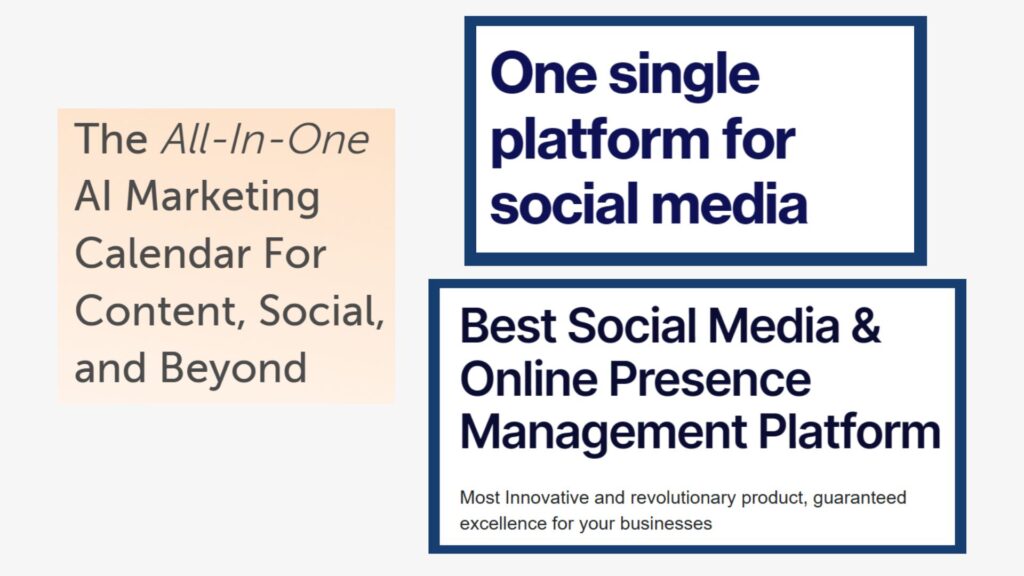
If this is the first thing you see from their brands (and if you even read them in the first place), you will see the companies as the exact same thing.
Is there a SMM tool that doesn’t promise to be All-In-One?
Is there a SMM tool that doesn’t think they’re the best?
Is there a SMM tool that doesn’t promise organization?
B) Inviting a comparison
Most attempt to show their brand, service, or product is incrementally better, faster, easier-to-use than others in a category:
👉 “The best employee communication tool”
👉 “We get you results 5x faster than other franchise marketing services”
👉 “The easiest-to-use client onboarding platform”
Christopher Lochhead calls this The Better Trap.
It’s pretty logical. If buyers know we’re the best brand with the best service, they’ll buy from us, right?
Well, like usual, B2B companies completely forget to consider the buyer’s point of view. When seen from the eyes of a modern digital buyer, suffering from Choice Overload (too many choices and all of the same promises) – all this tells them is that you are completely Interchangeable.
When you say you’re the ‘best kind of X’, it’s only telling them you’re not different from any other X.
Remember, marketing is not about reality. It’s about the perception of reality. Trying to convince buyers that you’re the best doesn’t change their perception (because no one believes you).
2) When you don’t address a painful problem, in the mind of the buyer you’re perceived as a Nice-To-Have.
Benefits, products, services, and brands are all Nice-To-Haves.
It’d be nice to ‘accelerate growth.’
It’d be nice to ‘unleash our potential’ (whatever the fuck that means).
It’d be nice to have ‘an all-in-one platform for {category}.’
It’d be nice to ‘work with a brand that puts the customer first.’
Why isn’t any of the ad messages from above a Need-To-Have? Because it doesn’t address any current pain or potential pain (created by a problem). Anything else can be deprioritized and pushed off for the future.
Now that we understand the difference between the perceptions of being Irreplaceable Need-To-Haves or Interchangeable Nice-To-Haves, let’s compare how it affects what your marketing and sales teams care most about: financial outcomes. Inbound calls, intent, win rates, sales cycles and CAC’s.

1) A Problem-Focused Message in B2B Ads Impacts Intent
When you market the problem, you get more high intent inbound calls. That’s because painful problems Need To Have solutions.
The outcome that the marketing team would like to hear.
When the painful problem you solve becomes visible and understood by the buyers, they demand the solution from you. This is why we don’t just say you get more booked calls (or demos). You get more high intent booked calls.
Let’s look at an example:
Before working at Black Camel Agency, Dylan offered a Linkedin demand creation service. One of his B2B clients, a franchise marketing agency, in the first few months of launching their Linkedin ad campaign, was getting several qualified and high intent inbound booked calls each week.
Prospects weren’t being begged to get on a call. They weren’t being tricked to get on a call with fancy schmancy sweet talk. They most certainly weren’t downloading an eBook on ‘industry trends’ only to then be called by a sales rep.
What Dylan and the client did was market the problem and educated about it. As a result, buyers were going out of their way to book a call because they realized it was a problem they needed to solve. They saw that the problem was causing them tons of pain: resource waste and marketing strategy confusion.
These weren’t calls to buy a $10k rebranding package. They were deals that result in $100k to $300k in MRR for years down the road.
The best part? The monthly ad spend to get all these was below $1K.
They could’ve made an advertising message that said:
👉 ‘We know franchise marketing more than anyone!’
👉 ‘Look at us! We’re on a mission committed to excellence.’
👉 ‘Here’s an eBook on general franchise trends.’
👉 ‘We’re the best franchise marketing agency!’
Instead, they said, ‘Here’s your problem and the pains it creates.’
Buyers don’t perceive the brand as an Interchangeable Nice-To-Have service. They perceive it as the Irreplaceable Need-To-Have solution to a massive problem.
A valley is not a valley without a mountain.
The yin cannot be without the yang.
A solution cannot exist without a problem.
When someone shoves a ‘solution’ in your face, you ask (often subconsciously), ‘why should I care?’ And because it doesn’t tell you why you should care, you scroll on.
The problem is what makes buyers care.
Solutions don’t inspire action. Problems do. That’s because problems are about THEM, the buyers. Your solution (product, brand, and service) is about YOU.
Problems initiate the buying journey.
A problem that people can’t go around.
A problem that causes them pain now.
A problem that will cause even more pain the longer it goes unsolved.
A problem that, if unsolved, will prevent them from achieving their desired outcome.
A problem that when solved, unlocks specific benefits.
Again, this is why a solution to a problem is a Need-To-Have.
A general rule of hoof (we’d say thumb but we’re Black Camels):
The more visible the pain and the clearer it is that the problem causes that pain, the higher the perceived value is of your solution. An increase in perception of the value of your solution results in an increase in high intent booked calls.
2) A Problem-Focused Message in B2B Ads Impacts Win Rates
When you market the problem, you get a higher win rate. That’s because when you own the problem in the buyer’s mind, prospects see you as the Irreplaceable and obvious solution.
The outcome the sales team would like to hear.
In most B2B companies, marketing and sales hate each other. Marketing says, ‘We have to produce more leads because sales sucks at closing them.’ Sales says, ‘We need more leads because marketing sucks at getting leads that actually want our product/service.’
It’s a bit of a chicken or the egg dilemma. But instead of continuing with the costly blame game, perhaps we should consider that both are wrong.
Maybe we shouldn’t be trying to get more leads just to increase a number in a platform dashboard. But maybe instead, we should be trying to attract leads with the right perception.
Let’s look at an example.
Clari, the enterprise revenue platform, decided that instead of evangelizing their solution, what it does, why it’s better, and why people should buy it, they should market the problem.
They could’ve said, ‘we help you save money!’ But instead, they framed the problem like this:
In times of uncertainty, most companies only focus on one thing: cutting costs. But that’s only half a strategy. A full strategy requires managing costs AND revenue. Actually, it’s not simply “managing revenue”. It’s managing Time to Revenue – the time it takes to set up your tech stack, harvest relevant signals, analyze, act, and drive revenue. And legacy systems are not purpose-built to optimize Time to Revenue. Which wastes time and results in Revenue Leak.
They made buyers realize the painful problem that they have to show them that they needed the solution (their revenue platform). And that they were the only obvious solution for it (because no one else understood the problem like they did).
It’s what contributed to increasing their win rate by 64% (and decreasing CACs by 67%).
How could changing the ad campaign message have such a huge impact? After all, the win rate is a sales metric…right?
Sure, the quality of your sales team naturally has an impact on the win rate. But if the leads that are being fed to your sales team 1) don’t understand the problem you solve and 2) think they can find something similar elsewhere, then there’s only so much a good sales rep can do.
You don’t need more leads. You need leads with the perception that you’re an Irreplaceable Need-To-Have solution.
Great salespeople already know that they need to educate about the problem and connect it to their solution. It’s lesson #1 in sales. But although this is obvious for salespeople, us marketers have forgotten the importance of the problem.
To achieve true alignment, both marketing and sales need to work together to make the problem highly visible, own it in the buyers’ mind, and connect it to the solution.
What does it mean to own a problem in the buyer’s mind?
The 5th law of marketing in The 22 Immutable Laws of Marketing (1993) by Al Ries and Jack Trout is called the Law of Focus. “You ‘burn’ your way into the mind by narrowing the focus to a single word or concept. It’s the ultimate marketing sacrifice.”
When buyers think of your brand, the instinct is to think of that concept. In B2B, that concept should be the problem. We need to narrow the focus to the problem, claim it, and own it.
Let’s use an example we’re all familiar with to understand why.
You’re feeling sick.
You go to the doctor. You list all the symptoms and pains that you feel. The doctor diagnoses you with Fake Example Syndrome (yes, this a fake disease we’ve created as an example), making you aware of the problem you have.
She explains why Fake Example Syndrome exists, how it causes the pain you feel, the consequences of not curing it, the different treatments for it, the different scenarios in which a certain treatment is best, what most people suffering from it do, etc.
In simple terms, she educates you on the problem and shows her understanding of it.
From your perspective, someone that best understands the problem best understands the solution to it. (Something tied very closely with the psychological bias called, Expertise Heuristic.)
When you market the problem, buyers aren’t thinking, ‘Where else can we get this service?’ They’re thinking, ‘Thank you, Expert, how do I solve this problem?’
And this has a huge effect on the win rate.
Because when you’re perceived as Interchangeable, buyers might get on a call (or two) with you. But then…
👉 you get ghosted because they decide to buy a perceived-to-be-similar* service
👉 customers won’t pay you a premium price (because they think they can get the same thing for cheaper elsewhere)
*We say perceived-to-be-similar as a reminder that marketing is a battle for perception, not reality. Your service might be the best solution, but buyers may not see it that way.
General rule of hoof #2:
The more you show your understanding of the painful problem and make them aware of it, the more they think you are the only one that can solve it. This means less ghosting and deal loss.
3) A Problem-Focused Message in B2B Ads Impacts Sales Cycles
When you market the problem, your marketing funnel and sales pipeline moves faster. Painful problems force urgent action and prioritization.
Another outcome both your marketing and sales team would like to hear.
What’s the difference between going directly to the emergency room right now and your yearly check-up a year from now? The emergency room visit is a Need-To-Have and the yearly check-up is a Nice-To-Have.
What creates that difference in perception?
The awareness of a problem that causes pain now.
Let’s say you’re preparing dinner at home. Your 5-year-old keeps distracting you. You’re cutting up some carrots but you concerningly look over at your kid because he’s pulling on your not-so-kid-friendly cat’s tail. And…oops! You look back at the cutting board. That wasn’t a carrot. Silly you, that was your finger!
Now, let’s look at the two possible reactions to your realization that you can no longer give high fives, only high four and a halfs.
Possible reaction 1:
“Darn, I just cut off my finger. Gee whiz, am I clumsy or what? There’s blood everywhere. Eh, that’s alright. I’ve got my yearly checkup next Thursday. I’ve got a bunch of other stuff I’d like to do this week before I get to that.”
Possible reaction 2:
“Fuck!! Ahhhhh!! Fuck! Fuck! Get me to the fucking hospital right NOW! Fucking fuck!!
If you’re like most functioning humans, you would experience the second reaction, expressing urgency and prioritization. That’s because you would experience a rather acute feeling of pain, realize the problem that’s causing that pain, and foresee the consequences of not solving it (bleeding out from a lost pinky).
But unlike in this metaphor with our own physical body, in business it’s a lot more difficult to connect the pains with the problem causing it. We need someone to make us aware of a problem (or make it more visible) and show how it’s connected to our pain.
Just like how…
Hubspot showed us how our pains were caused by outbound marketing.
Salesforce showed us how our pains were caused by on-premise CRM.
Slack showed us how our pains were caused by channel-less work communication.
Real Urgency vs Superficial Urgency
In 2024, the only way to create Real Urgency and prioritization is to:
- make the problem highly visible from the first interaction
- emphasize how the pain caused by the problem will continue or worsen if left unsolved.
Unfortunately, most B2B companies don’t do this. They market the solution before the problem. But then they realize that their solution itself is not enough to create urgency and prioritization.
So, they resort to Superficial Urgency – which we can define by the manipulation of a sense of urgency in marketing or sales messages that don’t genuinely reflect a true urgency or necessity.
Phrases, tactics, and techniques like “limited time offer,” “sale ends soon,” or “Only 2 onboarding spots for clients left this month.” But when you attach “limited time offer” to something people don’t really feel like they even need in the first place, it doesn’t create much urgency.
And just like buyers have built up a resistance to ads because of Ad Overload, they’ve built up a resistance to these tactics because of Superficial Urgency Overload. When the human brain is overloaded with information, whether that be ads or promises of ‘limited time offers’, its defense mechanism is to ignore the high majority of it.
Superficial Urgency simply doesn’t work like it used to.
The lack of urgency in buyers is most visible in sales conversations. But it starts in the marketing funnel (research stage) from the very first moment you interact with them.


1) Urgency in the marketing funnel – the research stage
According to Forrester research, 68% of B2B buyers prefer to research on their own, online. 60% prefer not to interact with a sales rep as the primary source of information.
So, what this means is that a buyer might meet the criteria to be ready to buy but doesn’t go out of their way to do their own research. Because it’s not clear to them why they should.
The reality could have been that they had the financial means and should have bought the service 3 years ago. But they didn’t. Because nothing was creating the urgency and prioritization that was pushing them along in the buying journey.
Let’s compare two buyers:
Buyer A sees your Attention Repellent Ads. Over and over.
“Great, that service would be nice to have. But I’ve got other pressing matters right now. I’ll keep scrolling”. And only after 3 years of seeing your ads over and over again, they finally end up clicking through to your website. It took 3 years to initiate the buying journey!
Buyer B sees your Problemotional Ad where you make the problem visible.
“Oh wow, that’s a big problem that I have. I didn’t even realize* I’m losing a bunch of money right now!” And then they click through to start learning more about the problem and how to solve it ASAP. Instead of taking 3 years to initiate the buying journey, they start now. Because they understand the painful problem.
*Sometimes marketing the problem doesn’t mean make them realize they have a problem. Sometimes they’re already aware of it, it’s just not very visible, understood, or felt.
We use this little example to explain that by marketing the problem, it doesn’t just speed up the sales cycle. It also speeds up the marketing funnel.
If 68% of B2B buyers prefer to do their own research online, we need to get them to start doing their research NOW. There’s no sales rep that can urge them along.
If we go back to our buying journey graphic from the beginning, we can see how Buyer A didn’t care about the solution and Buyer B did. Buyer A was still in the Unaware stage and Buyer B was in the Problem Aware stage.
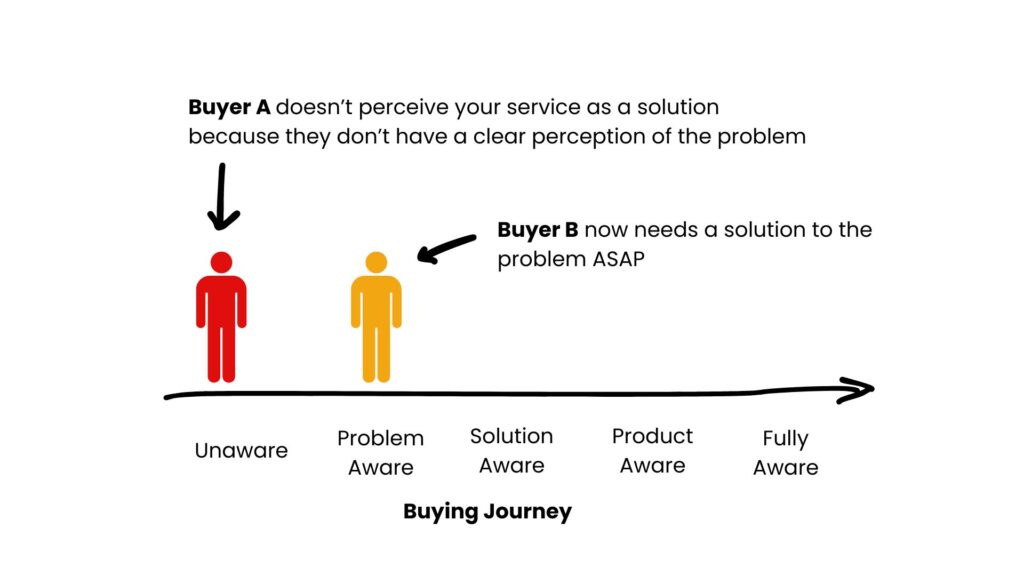
If the problem is not well established, buyers remain in the Unaware or Problem Aware stages longer, delaying their progression to the Solution Aware and Decision stages.
2) Urgency in the sales pipeline – the conversation stage
“Yeah, it sounds good. Let us think it over a bit and get back to you.”
“I definitely see how it helps. We just have more pressing matters right now.”
“Hey, something came up. Could we reschedule the call for next week?”
Sound familiar?
The buyers that you’re in contact with might be interested. But they push it off into Neverland – always politely reassuring that they’re interested, apologizing for being busy, and blaming ‘emergencies’ until eventually they’re no longer responding to your messages.
If you’ve heard any of this coming from your prospects, that’s a big red flag. What they’re really saying is, ‘We don’t think buying is an urgent priority.” And this isn’t the fault of the sales team.
It’s because the problem wasn’t well established in the buyers’ minds from the beginning.
Many sales gurus will argue that the best way to shorten the sales cycle is to reduce friction. The typical solution to the lack of urgency in both areas are quick-fix tactics that only result in incremental improvements.
At Black Camel, we’re more into Big Fucking Improvements.
But hey, maybe incremental is more your thing. We’ll only judge you a lot.
4) A Problem-Focused Message Affects CACs
When you market the problem, you achieve lower customer acquisition costs. When your ads are effective, less ad spend is needed and profitability is maximized.
The outcome your CFO will like to hear.
This one isn’t rocket science.
When you’re perceived as an Irreplaceable Need-To-Have and get more booked calls/demos that close more and faster, you can reduce costs from:
- ad spend (ads that work don’t require as many eyeballs)
- sales training (no need to train sales when buyers are already handing you money)
- travel costs (no need for constant traveling when buyers buy from fewer meetings)
- sales reps’ and marketers’ salaries (no need to hire more to get the results you want)
Disclaimer: We are NOT advising you to lay your sales reps and marketers off! We’re just saying that you won’t need to hire more to get the same results.
Growth, profitability, and scalability are all achieved when your advertising has the right message. But only when it’s actually heard and remembered.
What we’re saying (the problem) is important in creating the right perception. But what about how we’re saying it?
Just because we’re advertising the right message doesn’t guarantee that the message is:
- heard
- remembered
- shared
This is where the second part of Probl-emotional comes into the picture.
Read Emotional B2B Advertising: You Can’t Bore Strangers Into Listening And Remembering.


